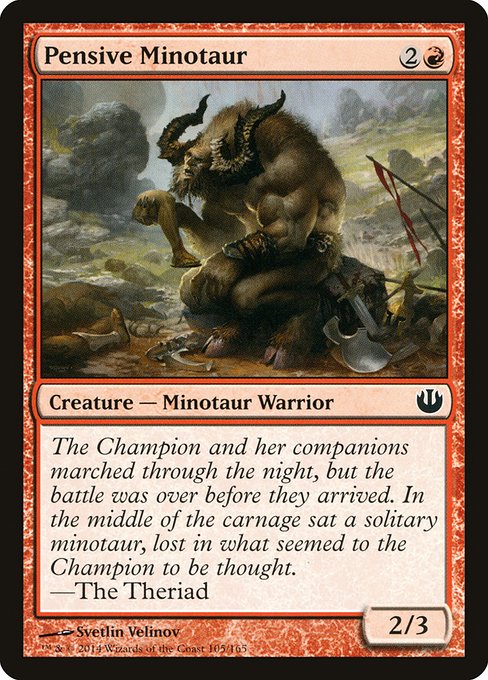
Image courtesy of Scryfall.com
The price pulse: digital markets, physical reality, and a red minotaur that proves the point
If you’ve ever tried price-tracking MTG cards across formats, you know that the digital market moves faster than a goblin at a treasure vault. Pensive Minotaur, a red Journey into Nyx creature, sits in a curious spot in that ecosystem. With a mana cost of {2}{R} and a modest 2/3 body, it’s not a bomb in constructed play, nor a lock in standard rotations. But its journey from paper to pixels offers a revealing snapshot of how digital pricing interacts with the physical market. On paper, it’s a common creature—readily available, easy to pull in draft and sealed product—yet the foil version commands nearly nine times the nonfoil price in some markets, around $0.87 for foil versus about $0.03 for nonfoil, according to current listings. That foil premium isn’t from power; it’s about rarity, aesthetics, and the finite nature of physical foils in a world of endless digital decks 🧙♂️🔥.
The card’s arc tells a larger story about scarcity and access. The nonfoil version is plentiful enough to be a budget option for new players and EDH enthusiasts alike, especially given its common rarity and the reliable supply from Journeys into Nyx print runs. The foil, however, captures a different kind of value—one that’s driven by the tactile allure of foil finishes, the collector’s impulse, and the physical card market’s lag between demand spikes and supply adjustments. The flavor text—“The Champion and her companions marched through the night, but the battle was over before they arrived. In the middle of the carnage sat a solitary minotaur, lost in what seemed to the Champion to be thought.”—hints at a card that’s less about battlefield immediacy and more about character and lore. That flavor, paired with the art by Svetlin Velinov, can nudge why some players chase the foil version even when the nonfoil remains perfectly serviceable in many decks 🎨.
From a market perspective, Pensive Minotaur is a microcosm of digital versus physical pricing. In digital ecosystems—think MTGO or MTG Arena—prices react in real time to deck archetypes, metagame shifts, and the constant churn of new content. A card like this minotaur can spike or slump with a single meta decision, a popular red deck, or even a streamer’s deck tech, all while the physical market experiences a slower cadence shaped by print runs, card stores, and regional demand. The lack of a current reprint flag for this card in this print cycle doesn’t guarantee immunity to future reprint risk, but it does illustrate how digital price signals can diverge from paper pricing in the short term. Meanwhile, the physical foil market captures that premium for the tactile, collectible aspect that digital formats don’t replicate, highlighting the enduring value of surface finishes and card stock in a market saturated with digital copies 🧠💎.
For players weighing use-case against value, the modern question becomes: should you pursue the digital low-cost option or invest in nostalgia and craftsmanship through a foil? The data doesn’t say one path is categorically better; it says, choose based on your goals. If you’re optimizing a red creature suite in a casual or EDH shell, the nonfoil provides practical budget flexibility; if you’re a collector or a player who wants that glossy upgrade for a dedicated display or a showy deck, the foil might be worth the premium. And for investors, the foil multiplier on a commonly printed card raises interesting questions about how much scarcity (real or perceived) is enough to sustain premiums over time. In this space, price trends are a blend of human desire, supply chain realities, and the broader crypto-leaning curiosity that pervades digital asset conversations—plus a dash of showmanship for those who love the glow of a well-touched foil 🧙♂️⚔️.
Looking ahead, watch how digital pricing interacts with the physical world’s logistics and collector culture. Digital markets can react quickly to meta shifts and new tech simply by algorithm, while physical markets reflect real-world constraints—print cycles, foil distribution, and local shop inventories. Together, they form a dynamic ecosystem where even a common red creature can become a case study in value mechanics. For players who like to track these currents, Pensive Minotaur serves as a friendly reminder: do not underestimate the power of a card’s rarity, finish, and lore to drive price behavior across both spheres 🧙♂️💥.
Product spotlight: bridging desk vibes with MTG price talk
While you’re poring over price charts and trying to gauge when to strike on a foil or a nonfoil, you might also be tidying your desk for maximum focus. If you’re shopping for practical desk decor that keeps your workspace tidy and stylish, check out the Phone Stand Travel Desk Decor for Smartphones. It’s a neat companion for late-night price checks, strategy discussions, and the occasional quick screenshot of a market spike. Explore it here: Phone Stand Travel Desk Decor for Smartphones
More from our network
- https://crypto-acolytes.xyz/blog/post/from-arcade-cabinets-to-art-installations-a-new-gallery-trend/
- https://blog.digital-vault.xyz/blog/post/icingdeath-frost-tyrant-speculating-set-print-runs/
- https://crypto-acolytes.xyz/blog/post/chainlink-vs-band-protocol-which-oracle-powers-defi-better/
- https://crypto-acolytes.xyz/blog/post/web3s-next-wave-how-it-will-redefine-the-internet/
- https://crypto-acolytes.xyz/blog/post/exploring-defi-dashboards-a-practical-guide-for-users/